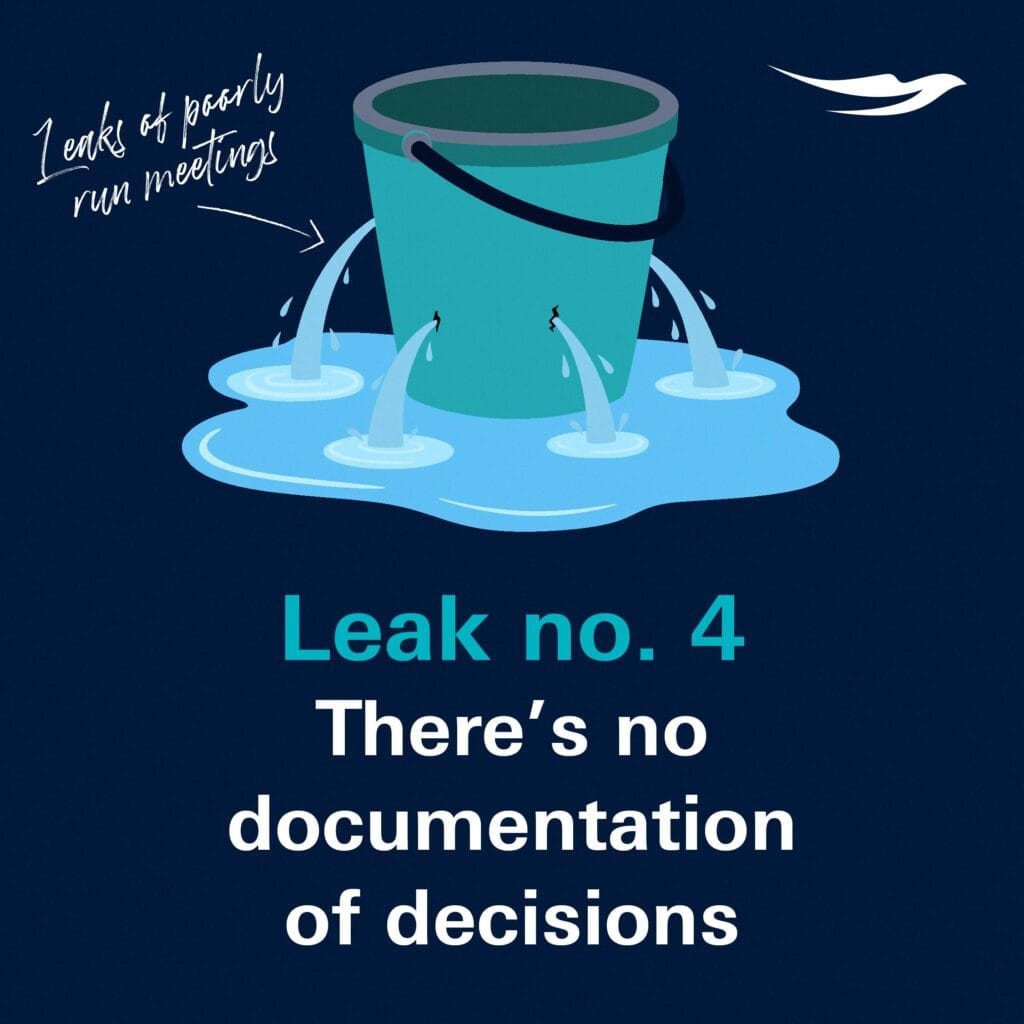5 Signs Your Meetings are Costing You Time and Money
Top Trending Posts

As Facilitators and enablers of change inside organisations, we persistently see that poorly run meetings cause significant waste inside organisations and frustration for those required to attend.
If you think of an organisation as a bucket that captures value in order to deliver to its clients, think about poorly run meetings as holes in the bottom of this bucket, eroding value, costing time and creating waste for staff involved.
Here are 5 signs that your organisation has a leaky bucket.
Sign 1 – Nobody (Including the Leader) is Prepared
Preparing for a meeting is a conscious act. It requires strategic attention to the purpose of the meeting, clarity around who should attend, what value they will add, and planning of a solid Agenda with a meaningful design.
If you’re planning a meeting, consider:
- What is the strategic concern your meeting will attend to?
- Who needs to attend and who is instrumental to the decision?
- Who simply needs to be informed and does not need to attend?
- What items must be discussed and form part of the Agenda?
- How can this meeting be designed to maximise engagement and outcomes?
Sign 2 – You Don’t Have the Information to Make a Good Decision

One of the main reasons to engage in a meeting, is to involve the right stakeholders in the right conversation to make an effective decision. Often this will require data and relevant inputs to make a sound decision.
If you have an important decision to make, consider:
- Who is attending this meeting and what contributions can they make?
- What data do you require to make an effective decision?
- Can you pre-prepare information and distribute it ahead of the meeting in the form of a Brief?
Sign 3 – Your Stakeholders are Disengaged or Bored

There’s nothing worse than running a meeting and watching people disengage or nod off. A well-designed meeting should have people engaged from the get-go, involved appropriately and, since they’re instrumental to the decisions, active in the discussions.
To improve engagement, consider:
- Making sure the right people are in the room.
- Allocating an appropriate amount of time for each Agenda item and not allowing people to waffle on.
- Designing interactive elements so that people can talk and contribute, rather than be passive.
Sign 4 – There’s no Documentation of Decisions

The very purpose of most meetings is to make decisions and commit to agreements that serve the strategic purpose of the organisation. If these are not documented via Minutes or a Commitment Register, they can be easily forgotten or misinterpreted. What a waste!
To avoid wasting precious time and to enhance accountability, consider:
- Making sure that every meeting is “Minuted”.
- Keeping a Commitment Register that identifies who is doing what and by when that item should be completed.
- Using a shared system so that your people can track and update commitments as they are achieved – e.g. Google Drive, Dropbox, Monday.com or an internal shared system.
Sign 5 – The Same People Dominate and Shape Discussions

It can be tricky to balance out personality dynamics in meetings, particularly if there are dominant people who speak more and others who don’t tend to offer their opinions unless asked. This can create an imbalance of perspectives and a lack of confidence that everyone will agree to the decisions being made.
To ensure that you create space for every voice, consider:
- Asking everyone to contribute to the decisions by sharing their perspective.
- Breaking into groups of two or three for a small chat before resuming the group meeting.
- Asking: “Can we hear from someone who hasn’t spoken yet?”
- Asking: “Does anybody have a different view, and could you share it now?”
We trust these hints and tips help you run better meetings! If you have found what we offer here helpful consider checking our out Online On Demand Program “Run Great Meetings”. In under 1 hour of video content with ready to use templates, you will learn how to think about, plan for, design, communicate and run meetings that translate to results and action.
Share This
Top Trending Posts
Sign Up
to our blogs and receive regular updates.

Stay in the Conversation
with Liberated Leaders...








